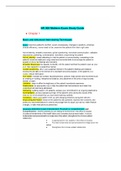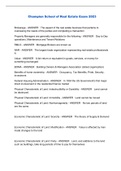, ● Helps identify or rule out physical causes related to patient
concerns
● Provides a baseline for future assessments
● Creates a platform for health promotion through education
and counseling
● Develops proficiency in the essential skills of physical
examination
Flexible Focused or problem-oriented assessment: For patients you know well returning for
routine care, or those with specific “urgent care” concerns like sore throat or knee pain. You will
adjust the scope of your history and physical examination to the situation at hand, keeping
several factors in mind: the magnitude and severity of the patient’s problems; the need for
thoroughness; the clinical setting—inpatient or outpatient, primary or subspecialty care; and the
time available.
● Is appropriate for established patients, especially during
routine or urgent care visits
● Addresses focused concerns or symptoms
● Assesses symptoms restricted to a specific body system
● Applies examination methods relevant to assessing the
concern or problem as thoroughly and carefully as possible
Tangential lighting: JVD, thyroid gland, and apical impulse of heart.
Components of the Health History Jenna/Ashley
Initial information
Identifying data and source of the history; reliability
Identifying data- age, gender, occupation, marital status
Source of history- usually patient. Can be: a family member or friend, letter of referral, or clinical
record.
Reliability- Varies according to the patient’s memory, trust, and mood.
Chief Complaint
Chief Complaint- Make every attempt to quote the patient’s own words.
Present Illness
Complete, clear and chronological description of the problem prompting the patient visit
Onset, setting in which it occurred, manifestations and any treatments
Should include 7 attributes of a symptom:
● Location
● Quality
● Quantity or severity
● Timing, onset, duration, frequency
● Setting in which it occurs
● Aggravating or relieving factors
● Associated manifestations
-Differential diagnosis is derived from the “pertinent positives” and “pertinent negatives” when
doing Review of Systems that are relevant to the chief complaint. A list of potential causes for
the patients problems.
,-Present illness should reveal patient’s responses to his or her symptoms and what effect this
has on their life.
-Each symptom needs its own paragraph and a full description.
-Medication should be documented, name, dose, route, and frequency. Home remedies, non-
prescriptions drugs, vitamins, minerals or herbal supplements, oral contraceptives, or borrowed
medications.
-Allergies-foods, insects, or environmental, including specific reaction
Tobacco use, including the type. If someone has quit, note for how long
-Alcohol and drug use should always be investigated and is often pertinent to the Presenting
Illness.
Past history
-Childhood Illness: measles, rubella, mumps, whooping cough, chickenpox, rheumatic fever,
scarlet fever, and polio. Also include any chronic childhood illness
-Adult illnesses: Provide information in each of the 4 areas:
● Medical: diabetes, hypertension, hepatitis, asthma and HIV;
hospitalizations; number and gender of sexual partners; and risk
taking sexual practices.
● Surgical: dates, indications, and types of operations
● Obstetric/gynecologic: Obstetric history, menstrual history,
methods of contraception, and sexual function.
● Psychiatric: Illness and time frame, diagnoses,
hospitalizations, and treatments.
-Health Maintenance: Find out if they are up to date on immunizations and screening tests.
Review Tb tests, pap smears, mammograms, stool tests for occult blood, colonoscopy,
cholesterol levels etc..
Family history
Outlines or diagrams age and health, or age and cause of death, of siblings, parents, and
grandparents
Documents presence or absence of specific illnesses in family, such as hypertension, coronary
artery disease, elevated cholesterol levels, stroke, diabetes, thyroid or renal disease, arthritis,
tuberculosis, asthma or lung disease, headache, seizure disorder, mental illness, suicide,
substance abuse, and allergies, and symptoms reported by patient.
Ask about history of breast, ovarian, colon, or prostate cancer
Ask about Genetically transmitted diseases
Personal or social history
, Describes educational level, occupation, family of origin, current household, personal interests,
and lifestyle
Capture the patients personality and interests, sources of support, coping style, strengths, and
concerns
Includes lifestyle habits that promote health or create risk, such as exercise and diet, safety
measures, sexual practices, and use of alcohol, drugs, and tobacco
Expanded personal and social history personalizes your relationship with the patient and builds
a rapport
Review of systems pg 11-13
Documents presence or absence of common symptoms related to each of the major body
systems
Understanding and using Review of Systems questions may seem challenging at first. These
“yes-no” questions should come at the end of the inter- view. Think about asking a series of
questions going from “head to toe.” It is helpful to prepare the patient by saying, “The next part
of the history may feel like a hundred questions, but it is important to make sure we have not
missed anything.”
Most Review of Systems questions pertain to symptoms, but on occasion, some clinicians
include diseases like pneumonia or tuberculosis.
Note that as you elicit the Present Illness, you may also draw on Review of Systems questions
related to system(s) relevant to the Chief Complaint to establish “pertinent positives and
negatives” that help clarify the diagnosis.
For example, after a full description of chest pain, you may ask, “Do you have any history of
high blood pressure . . . palpitations . . . shortness of breath . . . swelling in your ankles or feet?”
or even move to questions from the Respiratory or Gastrointestinal Review of Systems
The Review of Systems questions may uncover problems that the patient has overlooked,
particularly in areas unrelated to the Present Illness. Significant health events, such as past
surgery, hospitalization for a major prior illness, or a parent’s death, require full exploration.
Keep your technique flexible.
Remember that major health events discovered during the Review of Systems should be moved
to the Present Illness Past History in your write-up.
Some experienced clinicians do the Review of Systems during the physical examination, asking
about the ears, for example, as they examine them. If the patient has only a few symptoms, this
combination can be efficient. If there are multiple symptoms, however, this can disrupt the flow
of both the history and examination, and necessary note taking becomes awkward
The Review of Systems: Pg. 12-13 ROS Chart Copied from online book
General: Usual weight, recent weight change, clothing that fits more tightly or loosely than before;
weakness, fatigue, or fever. Skin: Rashes, lumps, sores, itching, dryness, changes in color; changes in
hair or nails; changes in size or color of moles.
Head, Eyes, Ears, Nose, Throat (HEENT): Head: Headache, head injury, dizziness,
lightheadedness. Eyes: Vision, glasses or contact lenses, last examination, pain, redness,





